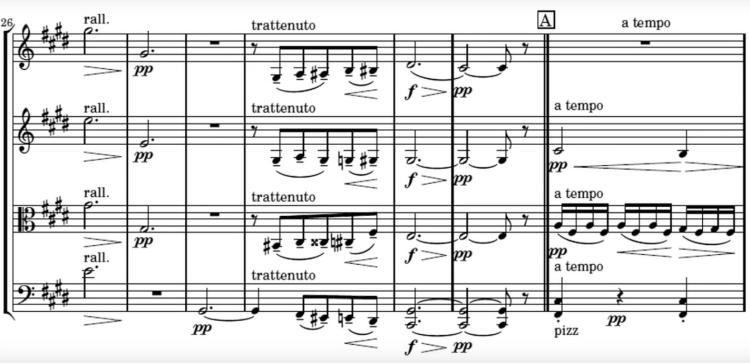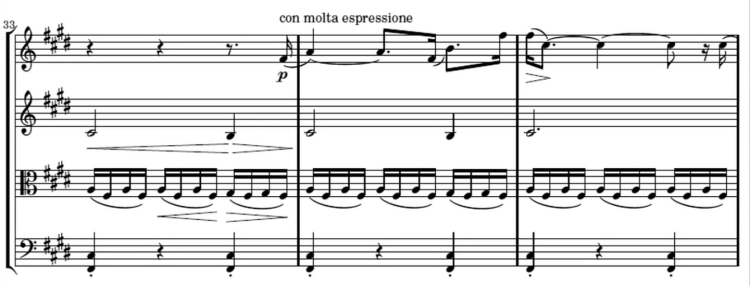I enjoyed this first week of Mario RPG. I think we all had a lot of good energy for analysis on this one. Hear us discuss our love and appreciation for Yoko Shimomura’s music!
I enjoyed this first week of Mario RPG. I think we all had a lot of good energy for analysis on this one. Hear us discuss our love and appreciation for Yoko Shimomura’s music!
This whole movement is so effortlessly cool to me, because it combines Superman, Tango cello lines/castanets, offstage horn players, and the Dies Irae. It’s pretty difficult to top Symphonie Fantastique’s use of the Dies Irae in an orchestral setting.
This movement is just perfect, but the moment is about halfway through where the strings take the melody and the friggin’ timpani takes the tango bassline for the first time, with the incredible brass commentary punctuating the string statements. Such exciting music. See this version with Toscanini conducting, which starts right before that moment:
…In which we begin showing our faces on the stream. The more we do it, the more we seem to refine the format and tech side of things. This isn’t my favorite playthrough; Ryan initially wanted to do the whole game in one week. Speedrun + scholarly commentary = not happening. I was definitely off my game in terms of talking about the music, because it was going by so fast and speed running requires doing a lot of things sort of out of order, so I was super thrown by that. Felt like I couldn’t catch my breath.
Live and learn, though. That just tells me I should do a personal run of the game down the line on my Twitch, to get a second chance at talking through it! That said, in listening back, it’s not like it’s completely devoid of musical analysis. And I dug the playing with format–marking objects up top as we got them in the game was a cute touch, and one I’d love to see happen again at some point.
So, I had this gig teaching chamber music. I’d go in a few times a week to coach small groups on classical repertoire, preparing them for OMEA Solo & Ensemble contest and school performances.
One day, my violin/viola duo admitted that they were working together on a heck of a lot more than Mozart. When they told me that they were arranging and learning music from video games, I couldn’t believe it. “Do you know what my dissertation is about?!?” I asked them. The group immediately shifted focus. They got their 1 ranking at OMEA on the Mozart, then we threw ourselves into the task of building up a repertoire of video game music in the hopes of putting on a full recital. Initially, the music directors were a little skeptical about the rigor of the work–until I showed them the score for our Castlevania arrangement. These two were performing such wickedly difficult material, and they were excelling at it because they were passionate about learning the music.
They were insistent on trying to learn pieces in the original keys, as close to the original tempo as possible (while acknowledging that some of the tempos in, say, Mega Man, are almost impossible to execute on our instruments). This entire process taught them–and me–a great deal about arranging, texture, rhythm, and what is idiomatic for keyboards vs. string instruments.
We finally put on a full recital here in town, taking a donation at the door for the Crohn’s and Colitis Foundation of America. We raised $150 for the cause, and shared some wonderful music with our audience. Several of my friends who came were floored to learn that these two were in high school–they assumed based on the final product that these two were college students! Their dedication, passion, and musical maturity really came together to create something truly special, and I am still so proud of what they accomplished.
Concert Order:
Welcome to my new series, in which I briefly present my favorite moments in music history. Instead of discussing entire pieces or songs, this series of posts will focus on intimate glances into music–formal sections, motives, phrases, even single chord changes that have had a powerful effect on me at some point in my formal or informal musical studies.
My undergraduate institution was fairly focused on early music, and so I didn’t have a lot of exposure to the major operatic repertoire. Not only was it not an emphasis in my music history courses, I never had the opportunity to play in the pit orchestra for one until I started my doctorate (Falstaff, in case you were curious). If it weren’t for my opera singer best friend from undergrad, I might still be woefully ignorant of all opera (though I still admit that I have a long way to go). I learned, eventually, that 20th century opera resonates powerfully with me–so I’m convinced that there is opera for everyone, if you expose yourself to enough of it. Some people want a good story with beautiful vocal lines, others value rich orchestration, but operas are often good stories.
During my master’s degree, the string orchestra performed Puccini’s I Crisantemi on a concert. I had never performed Puccini before, due to my lack of opera experience. And the man was practically singularly known for his operas–though he loved the string quartet, he left only four short works for the medium. The elegiac I Crisantemi isn’t what I’d call exceedingly popular in the orchestral or chamber music repertoire, though others may beg to differ. When I came across it, I thought it was a really striking and unexpected choice for a program.
Puccini claims to have written it in a single night in 1890, in response to the the death of a friend. The intense feeling that gave rise to these melodies resonated with the composer (just as it has with his audiences); he later re-used the melodies of I Crisantemi in his opera Manon Lescaut (1893).
The moment in Puccini’s “I Crisantemi” where I get real chills is the B section a little bit before minute 3…where the low strings have the ostinato underneath the violin melody. That whole section is like magic. It happens at 2:04 in this video, after a cathartic exhale of a chord.

I love the way the trattenuto measure begins this musical sigh that lets out the tension of all of that motive’s chromaticism in the final measure of the A section.
What is it about this moment? It’s one part contrast–the textural change of moving from lush homophony and the passionate dynamic swells that came before it to this softly undulating wave. But a piece of it also has to be the melodic contour–the leaps in the first violin melody are like question marks, open-ended and yearning and hesitant.

The questioning leaps in the first violin melody against the softly rolling wave in the violas.
It’s an incredible tune to contrast with the chromatic climb of the opening gesture, which was less like a question mark and more of a slow, deliberate intake of breath followed by the resolution at the top of the ascent each time.
It’s specifically the first iteration of this that gives me the thrill. At 2:54, the cello joins the violin (now up an octave), and it’s gorgeous (and no moment of this piece isn’t, in all honesty), but there’s always been something about the transition in particular that captivates me. It’s a moment that caught my breath and I remember listening to it over and over again, moving the cursor back on recordings and on YouTube. Perhaps it will catch you, as well.
Takeo Ischi is joy.
I’m kind of obsessed with this video right now. For those that don’t know NSP, one of the members is also on Game Grumps, one of the more entertaining Let’s Play-style YouTube channels out there.
Because who doesn’t want to see videos of cosmonauts dancing on a bowl of borscht? This video is courtesy of my advisor, who sent it along to brighten my spirits while I deal with shingles.
My best friend Alana sent this to me while I’m quarantined with shingles. My nearest and dearest know that bizarre YouTube videos are the best medicine (other than, y’know, the anti-viral they have me on).
…In which I do my best to concentrate on the music of Chrono Trigger to distract me from my shingles diagnosis. Thursday was the most painful day of last week, and even the stronger pain medication didn’t dull things very much, so I was glad to have something to do that night. And we finished the game!